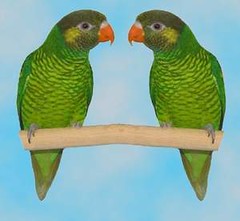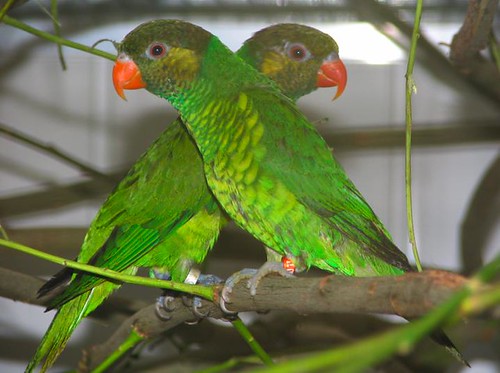tags: lories, Loriinae, Loriidae, ornithology, molecular biology, natural history museums
A young pair of Meyer's Lories (Lorikeets), Trichoglossus flavoviridis meyeri.
"Can you help us identify a mystery lory in our collection?"
I was pleasantly surprised to find this email request from Donna Dittmann, Collections Manager and Museum Preparator for the Section of Genetic Resources at Louisiana State University Museum of Natural Science in Baton Rouge, Louisiana.
"Sure," I wrote back. "Send it to me and I'll see what I can do."
I, and some of my lories, relocated to New York City in 2002 to begin a postdoctoral fellowship at the American Museum of Natural History, where I was examining evolutionary relationships among species of lories and lorikeets. To obtain essential materials for my research, I sent out requests to natural history museums around the world for tissue samples from the Loriinae, which led LSU to ask for assistance with identifying this particular museum study skin.
Tissue specimens are an excellent source of many proteins and particularly for the DNA used in a variety of research projects. These tissues (usually pieces of liver or skeletal muscle) are removed from animals that were either collected from the wild or that died in captivity and were donated to museums or universities. After the tissues are collected, they are carefully catalogued and stored in liquid nitrogen for use in future research projects. Many of these projects (including mine) were unimagined when these tissues were first collected a few years ago.
While many natural history museum study skin collections have specimens that are more than 100 years old, most museum tissue collections are very recent -- in fact, many were initiated during the 1980s. Due to the perishable nature of tissues, they are expensive to maintain and must be carefully managed and continually replenished. Unfortunately, funding shortages and other considerations have made it more difficult for museums to collect animals as often as they did in the past. Therefore, tissues from both wild and captive animals are limited, particularly those from rare and difficult-to-collect animals, such as lories.
 A few days after I received that email message, a package arrived in the mail. It contained a beautifully prepared -- almost lifelike -- study skin of a small lory. A tag delicately tied to the bird's right leg indicated that this skin was prepared on 7 December 1993 by DL Dittmann. Also mentioned on this small tag was the size of the bird's ovaries and that its skull was fully ossified, indicating that she was an adult female.
A few days after I received that email message, a package arrived in the mail. It contained a beautifully prepared -- almost lifelike -- study skin of a small lory. A tag delicately tied to the bird's right leg indicated that this skin was prepared on 7 December 1993 by DL Dittmann. Also mentioned on this small tag was the size of the bird's ovaries and that its skull was fully ossified, indicating that she was an adult female.
Lightly penciled on the tag was a tentative identification that this bird might be a hybrid between Trichoglossus iris and T. versicolor. But I knew with one glance that this was not a hybrid lory. Comparing this specimen to our study skins prepared from wild lories confirmed that this was a perfect example of Trichoglossus flavoviridis meyeri, commonly known in American aviculture as the Meyer's Lorikeet.
Closer inspection of the tag revealed that this bird came from Dick Schroeder's aviary in Inglewood, California in 1991. Mr. Schroeder, a good friend of mine, owns a birdseed supply company, Cuttlebone Plus and manufactures Avico specialty lory foods. Additionally, Mr. Schroeder has bred lories and other birds for more than 30 years.
Because museums leave all identification tags and bands in place on their study skins and skeletons, I looked more closely and discovered that this bird was banded. I contacted Mr. Schroeder with the band number to inquire about this bird's history. After recovering from his surprise that this bird was located in the LSU collections, Mr. Schroeder said that he bred and raised many Meyer's Lorikeets in the early 1980s and donated "anything unusual" to Kimball Garrett, the Ornithology Collections Manager at the Natural History Museum of Los Angeles County in Los Angeles, California.
I contacted Mr. Garrett to learn more about this particular specimen. According to Mr. Garrett, the Natural History Museum of Los Angeles County occasionally exchanges specimens with other institutions so this bird might have been included in such a trade with LSU. However, this event would have occurred more than ten years ago and unfortunately, there was no record of this exchange because the movement of lories between research institutions is not covered under any US Fish and Wildlife Service regulations (such as the Migratory Bird Treaty Act, for example).
And the best news of all? Tissues were obtained from this bird for the LSU tissue collection. The bird has been correctly identified and the tissues are now available to my research project and others like it. The DNA that I will obtain from this bird's tissues is precious because it represents another species and subspecies that I can add to my growing database of DNA sequences.
When analyzed, this DNA sequence data provides clues to the evolutionary relationships between all Loriinae genera and may result in reclassification of the entire subfamily. Further, analysis of these DNA sequences may result in the discovery of new species that have not been formally recognized previously. These discoveries are crucial for the future of both captive lory breeding and conservation efforts.
NOTE: I edited the original story, which was published by the LSU Natural History Museum newsletter in Spring, 2003, before publishing it here.
- Log in to post comments


Thanks for sharing a bit of your research with us.